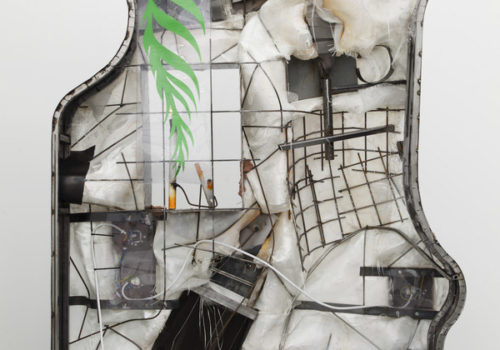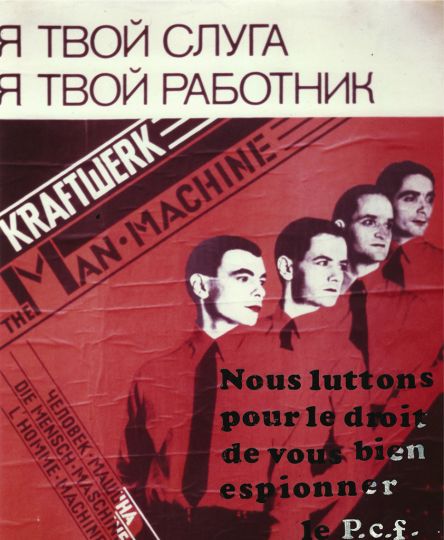The all-powerful Foire Internationale d’Art Contemporain (FIAC) consolidates its position as a leader in art with a high share of American participants (35 galleries), after France (42 galleries), out of 173 in total. Who are the participants whose hypnotic, wild images subvert the sometimes overly conservative landscape? Quirks and paradoxes.
Neïl Beloufa (1985, Paris), Balice Hertling Gallery :
A frontrunner for the Prix Marcel Duchamp, Neïl Beloufa describes himself as an installation artist fascinated by the proliferation of signs in a world dominated by the media. Inventing real mises-en-abyme, theaters within theatre, doppelganger effects, he explores the notion of the hors-champ and the documentary aspects of fiction.
Melik Ohanian (1969, Lyon), Chantal Crousel Gallery :
Short-listed for the Prix Marcel Duchamp, the photographer and video artist explores the various occurrences of the image and the film object in order to underscore their duplicity by way of various processes examining the exhibition space and the notion of time. For the Prix Marcel Duchamp, Ohanian focuses on the observation of the universal standard of measurement, the second, by means of a set of luminous panels the flickering of which marks the passage of Caessium 133 from the solid to the liquid state. It is a singular gesture at the heart of an experience on the passage of time.
Laëtitia Badaut Haussmann (1980, Paris), Allen galerie :
Appropriation, offsetting, direct citation, or analogy, Laëtitia Badaut Haussmann’s work expands the field of the image redefining what we see using historical, cinematographic, and conceptual criteria. Starting with the attributes of a modernist interior, as in Charlotte Perriand’s daybeds or the black-and-white photos in “Maisons françaises, une collection,” an ongoing series begun in 2012 and continuously reworked by the artist, Haussmann combines the vocabulary of literature, design, and architecture in order to construct a fictional trajectory and a new critical space.
Ryan Trecartin (1981, Texas), Andrea Rosen Gallery
Ryan Trecartin and Lizzie Fitch, recently exhibited at the Musée d’art modern de la Ville de Paris, redefine the concept of the author in the age of the Internet and social networking. They explore an explosive, protean virality in their videos in which their roles function as individual or collective performances. Whether it’s a question of technological or consumer trends, narcissistic temptations, or permanent permutations, their fevered exhilaration keeps expanding the territory and the content of images.
Richard Mosse (1980, Ireland), carlier | gebauer gallery :
The representative of his country at the 56th Venice Biennale and recipient of the Deutsche Börse award, Richard Mosse documented the deadly conflict in Congo using Kodak Aerochrome infrared-sensitive film, recently withdrawn from the market. Designed in the 1940s for the purposes of camouflage detection, the film makes it possible to see beneath the surface of things and reveal an almost surreal beauty of blood-colored landscapes. A phase shift uncovers the raw, brutal reality of the tragic conflict: clairvoyant violence!
Rachel Harrison (1966, New York) Greene Naftali Gallery
Partaking of high and low culture, ready-made and craftsmanship, anachronism and displacement, Rachel Harrison’s work constantly reinvents the collective memory that she cannibalizes with humor and delight. This series of portraits hung on the wall as a large frieze cultivates spatiotemporal juxtapositions and tongue-in-cheek slapstick. The Voyage of the Beagle, Darwin’s field journal of his 1830s’ voyage to the distant corners of South America and Australia, was a precursor to his theory of evolution. Rachel Harrison revisits this work in order to unravel its determinism by means of changing, hybrid identities.
Lydia Flem (1952, Brussels), galerie Françoise Paviot :
Writer and psychoanalyst, she uses photography in order to pass through the looking glass of illness by inventing a poetical form of “implicit journal” where every chance-generated object takes on a symbolic meaning. Fictional puzzles become singular, open-ended archives. Keys on a chessboard, wrinkled time, Opéra, Queen Alice—photographic writing interweaves emotions, painful events, and memories. Resilience is the essence.
Pat O’Neill and UCLA (University of California – Los Angeles) 1963-73 (Cherry and Martin):
UCLA’s Art Department played an important role in the 1960s and 1970s in the exploration of the materiality of the photographic process, seeking to free photography and establish it as a separate art form. Pat O’Neill (born in 1939 in Los Angeles) became actively engaged in that struggle alongside his professor, Robert Heinecken who was both anti-conformist and receptive to transgressions of the imposed purity of the medium.
FAIR
FIAC
22-25 October 2015
Grand Palais
Avenue Winston Churchill
75008 Paris

















